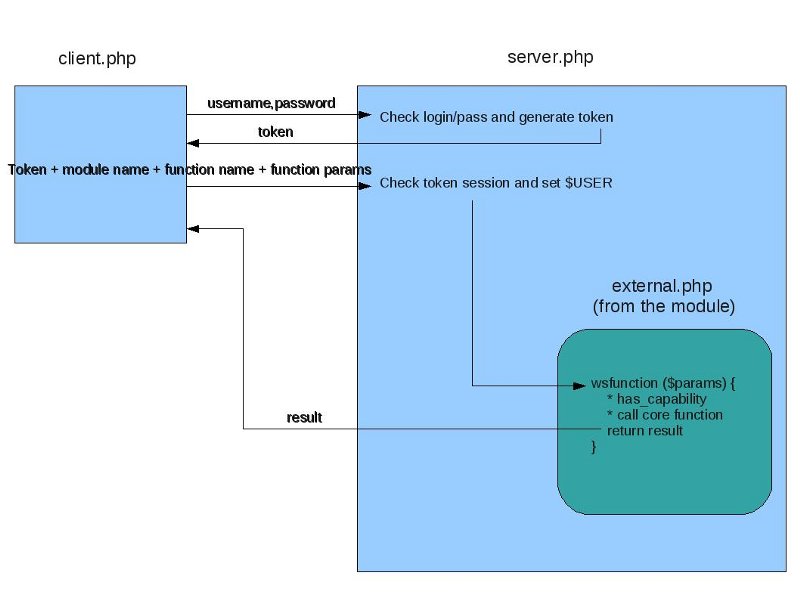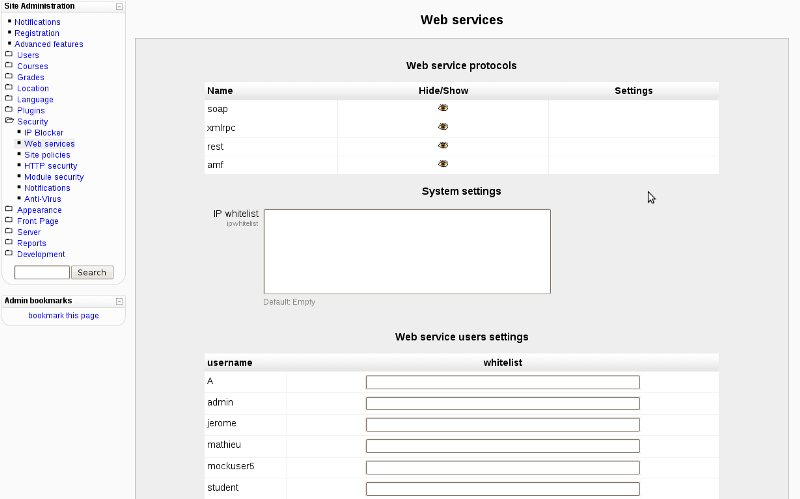Web services: Difference between revisions
No edit summary |
|||
| Line 7: | Line 7: | ||
=Implementation= | =Implementation= | ||
Web Services module has been conceived in a purpose to be ported on different Moodle version, and also on different project. It has also for purpose to support multiple web service protocols (REST, SOAP, AMF | Web Services module has been conceived in a purpose to be ported on different Moodle version, and also on different project. It has also for purpose to support multiple web service protocols (REST, SOAP, XML-RPC and AMF). Adding a new protocol support should be relatively easy. | ||
== How it works == | == How it works == | ||
Revision as of 05:47, 24 February 2009
Note: This page is a work-in-progress. Feedback and suggested improvements are welcome. Please join the discussion on moodle.org or use the page comments.
Moodle 2.0
Introduction
This page described the Web Services module implemented for Moodle 2.0
The tracker issue is here: MDL-12886
This module is been implemented by the DFWS Team and Moodle.
Implementation
Web Services module has been conceived in a purpose to be ported on different Moodle version, and also on different project. It has also for purpose to support multiple web service protocols (REST, SOAP, XML-RPC and AMF). Adding a new protocol support should be relatively easy.
How it works
- The client sends a username and password to the web service protocol server script.
- The protocol server returns a session token for that user account (how this is sent depends on the protocol).
- The client calls a particular web service function (module name, function name, and function parameters), including the session token.
- The protocol server uses the token to check that the session is still active.
- The protocol server call the matching external function, located in a external.php file inside the relevant module.
- The external function checks that the current user has_capability to do this operation.
- The external function calls the matching Moodle core function (in lib.php usually).
- The core function can return a result to the external function.
- The external function will return a result to the protocol server.
- The protocol server returns the result to the client.
phpDoc format
All callable functions are declared into each external.php. Function descriptions are declared into the phpDoc.
web services technical documentation
In order to facilitate a Moodle web service client implementation, we provide a page listing all function descriptions. We also give some useful advice for any supported protocol.
Authentication
Clients needing to use a web service will need a Moodle user account with the 'moodle/site:usewebservices' capability enabled. After the first login with username and password the session is retained with a token that gets passed with every web service request (until the session expires).
The Moodle administrator can control access to the site using the 'Security -> Web services' page, which contains settings for:
- enabling/disabling particular protocols (SOAP, REST, AMF, XMLRPC, ...)
- configure protocol-specific settings (though we can't think of any such settings)
- configure system-wide default settings (stored in config table):
- IP whitelist
- Anything else?
- configure per-user settings (stored in user_preferences):
- IP whitelist
- Anything else?
Each protocol will call a webservice authentication function before allowing access, which will:
- Check that particular protocol is enabled for the system
- Authenticate the user using username/password and normal auth plugins (internal, LDAP etc)
- Check that the user has 'moodle/site:usewebservices' at SYSTEM level.
- Check the per-user restrictions, if there are any, else check the system settings
- Create a session and return a token for the web service protocol to use.
This is probably enough (an auth/webservice is not necessary).

